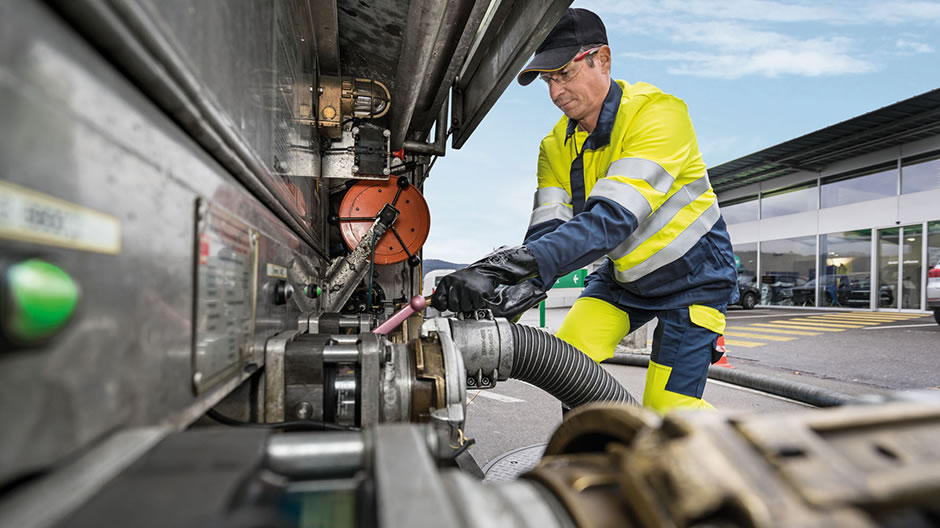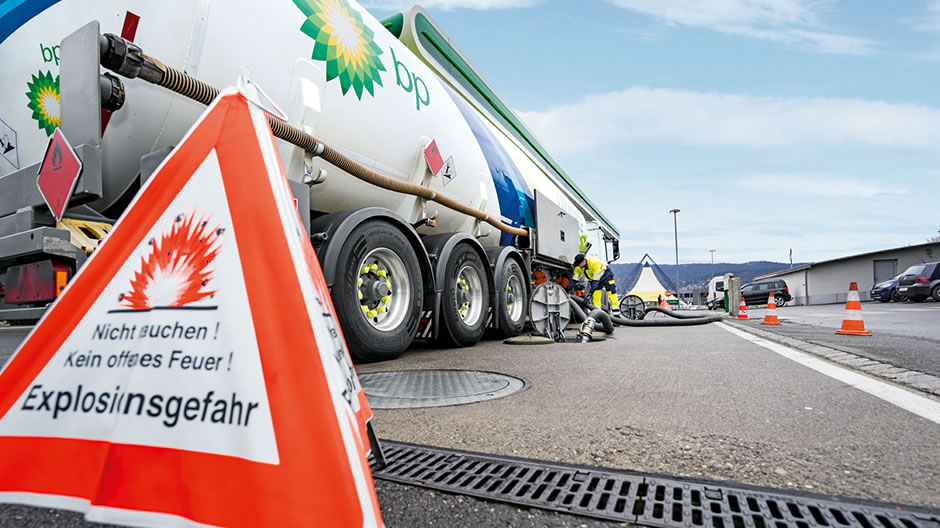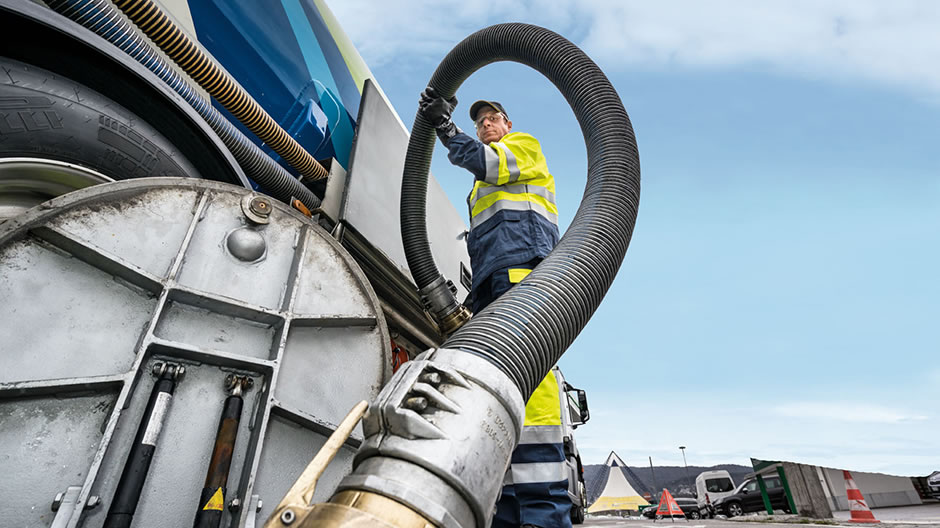
The Antos Loader at Petrologistics
Vehicle & Technology
The tanks of the Antos Loader are filled with around 27 tonnes of fuel before it sets off on the next trip.
Marcel Krähenbühl lets the Petrologistics tractor-trailer combination roll slowly on to the scales: 39 980 kilograms, bang on target. The three compartments of the tanker semitrailer with the big BP logo on the side are full to the brim with petrol and diesel fuel. The first trip of the day can begin. “A good thing that I still do a lot of sport,” says Krähenbühl with a smile. He was once a semi-professional in Switzerland’s third soccer league. “If I’d been 20 kilos overweight, it would have been close call!” The 45-year-old then steers carefully his Antos 1843 Loader from the premises of the tank depot in Rümlang near Zurich and merges with the ongoing traffic.
“Payload is an important factor for the success of our business,” says Krähenbühl’s boss Heinrich Heggli. He is a member of the executive board of the Heggli Group, which operates ARGE Petrologistics in collaboration with Indermühle AG Rekingen. “For this reason, when buying our trucks, bodies and trailers for the tanker fleet we attach importance to them weighing as little as possible themselves.”
Remuneration by Petrologistics customers is based on the quantity of fuel transported. Every litre of additional fuel improves the company’s bottom line. Nevertheless not all vehicles in the 20-strong fleet are configured – like Marcel Krähenbühl’s Antos Loader – in such a way that they can achieve the statutory maximum weight of 40 tonnes when fully loaded. This is due to the specific structure of fuel distribution. On many trips, the weight cannot be taken to the theoretical limit because the filling stations on the delivery list require smaller quantities only. Or because only manoeuvrable rigids can reach the otherwise inaccessible valleys and city filling stations – a typical problem in Switzerland.



Every additional litre of fuel on board the tanker boosts profitability.
On his morning trip today, however, Marcel Krähenbühl has a completely full truck, as he is delivering fuel to several big filling stations in the Alpine foothills. His first drop-off point is BP’s in Spreitenbach in the canton of Aargau. This will be followed by three more nearby BP stations, which he can supply completely without having to return to the fuel depot.
Heinrich Heggli knows from experience that anyone who wants to be successful as a transport service provider in the field of fuel distribution needs to continuously readjust the numerous parameters involved: “This is a crucial aspect, as the requirements are high, varied and subject to constant change.” Day-to-day business is relatively reliable. “But,” says Heggli, “the customers quite often opt for a new fuel depot for more general business reasons, which means that we as the distributor have to deploy drivers with the necessary know-how at other locations. The statutory requirements also change regularly.”
Fuels are dangerous goods, which means the safety of persons and of the environment always has top priority for Heggli. The truck drivers must be specially qualified and receive regular further training. Every two months, the Petrologistics drivers meet to discuss the latest developments and new stipulations. Once a year, they attend a full-day safety training course.
The technically custom-fitted vehicles also have to undergo a detailed certification process before the tankers can operate on the roads. In day-to-day operation they are subject to the strictest controls. The trailer accounts for two thirds of the purchase price of the kind of tractor-trailer combination that Krähenbühl is driving, the tractor unit only for about a third.
The stringent customs regulations and the fact that the fuel tank counters have to be recalibrated at very regular intervals are also characteristic of the control process in Switzerland. The counters rotate at high speed as Krähenbühl, wearing a safety vest, helmet and protective glasses, fills regular petrol into the underground storage chambers of the BP filling station in Spreitenbach. He subsequently works on the other two tanks of his semitrailer and supplies the station with premium-grade petrol and diesel. After about 40 minutes he sets off for the next drop-off point.
“Payloader fleet” at Petrologistics – clear focus on efficiency.
Petrologistics has been distributing fuels for BP for over 15 years in the German-speaking part of Switzerland. The country poses particular challenges to transport service providers, not only due to its topography. The Swiss truck toll, for example, which is officially called the Mileage-Based Heavy Goods Vehicle Fee (German abbreviation = LSVA), must be paid as from the very first kilometre driven throughout the country, and not, as in Germany, only on motorways and certain federal highways.
Petrologistics chose Euro VI trucks like the Antos Loader, which was also put into service in the vehicle fleet, at an early stage. Compared to Euro V trucks, the company thus saves ten centimes (approximately eight cents) per kilometre.
In addition to the LSVA, haulage in Switzerland is also particularly expensive in a European comparison because of a general ban on night-time driving for trucks. After Marcel Krähenbühl has distributed his three to five loads per day, not only his own shift is over but also that of his vehicle.
“We really have to make sure that everything in our fleet focuses on efficiency,” says Heinrich Heggli. Which brings the discussion back again to the issue of payload: “All of our trailers and tractor units are fitted with aluminium wheels. This way, we save 12 to 15 kilograms per wheel, which benefits the payload, and, if we’re not fully loaded when we operate, fuel consumption.”
Aluminium wheels are available factor-fitted for the Loader. Heinrich Heggli: “The Antos Loader could be compared to a strong lightweight sportsman: despite additional Euro VI technology, our Loader, with a weight of 6 900 kilograms, is still 250 kilograms lighter than our lightest vehicle in the fleet. This regularly gives the traffic dispatchers more room for manoeuvre in their planning.”
Photos: Matthias Aletsee



Comment
Please log in to post a comment.
No comments yet